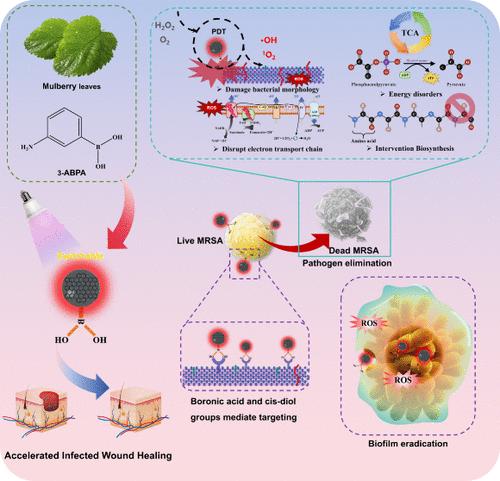桑叶碳点通过代谢扰动光动力治疗耐甲氧西林金黄色葡萄球菌感染伤口
IF 8.2
2区 材料科学
Q1 MATERIALS SCIENCE, MULTIDISCIPLINARY
引用次数: 0
摘要
抗生素耐药病原体对全球公共卫生构成重大挑战,特别是在与生物膜相关的难治性感染中。迫切需要开发创新的、安全的、具有治疗适应性的策略来对抗这些耐药生物膜。我们提出了一种新型的、精确的、可控的光动力抗菌碳点(B-M-CD),灵感来自桑叶的天然抗菌特性和硼酸的细菌靶向功能。该光催化抗菌剂具有良好的生物相容性,利用其固有的抗菌活性,以及光活化氧化酶模拟活性,产生活性氧,用于消灭耐甲氧西林金黄色葡萄球菌(MRSA)。通过利用细菌表面硼酸基团和顺式二醇基团之间的可逆共价结合,我们进一步增强了靶向抗菌活性。B-M-CDs有效地穿透细胞外聚合物物质,并表现出精确的光动力抗菌效果,允许针对生物膜抑制和破坏的局部递送。代谢组学分析显示,B-M-CDs破坏MRSA的氨基酸代谢、蛋白质合成、电子传递链和能量代谢。体内实验证实,该光催化剂可有效治疗mrsa诱导的伤口,其疗效可与万古霉素媲美,同时具有较高的生物相容性。这项研究首次开发了一种精确的、光激活的、可控的、靶向的碳基抗菌纳米酶,这种纳米酶来源于传统中药桑叶,为设计智能抗菌纳米剂提供了一种新的策略,并强调了它们作为类似MRSA感染的候选治疗药物的潜力。本文章由计算机程序翻译,如有差异,请以英文原文为准。

Mulberry Leaves-Derived Carbon Dots for Photodynamic Treatment of Methicillin-Resistant Staphylococcus aureus-Infected Wounds via Metabolic Perturbation
Antibiotic-resistant pathogens pose a significant global public health challenge, particularly in refractory infections associated with biofilms. The urgent development of innovative, safe, and therapeutically adaptive strategies to combat these resistant biofilms is essential. We present a novel, precise, and controllable photodynamic antibacterial carbon dot (B-M-CD) inspired by the natural antibacterial properties of the mulberry leaf and the bacterial targeting function of boric acid. This photocatalytic antibacterial agent exhibits good biocompatibility and utilizes its inherent antibacterial activities, along with photoactivated oxidase-mimicking activity, to generate reactive oxygen species for the eradication of methicillin-resistant Staphylococcus aureus (MRSA). By leveraging the reversible covalent binding between boronic acid groups and cis-diol groups on bacterial surfaces, we further enhance the targeted antibacterial activity. B-M-CDs effectively penetrate extracellular polymeric substances and demonstrate a precise photodynamic antibacterial effect, allowing for localized delivery aimed at biofilm inhibition and destruction. Metabolomic analyses reveal that B-M-CDs disrupt amino acid metabolism, protein synthesis, electron transport chain, and energy metabolism in MRSA. In vivo experiments confirm that this photocatalyst effectively treats MRSA-induced wounds with an efficacy comparable to that of vancomycin while also exhibiting high biocompatibility. This study represents the first development of a precise, photoactivated, controllable, and targeted carbon-based antibacterial nanozyme derived from the traditional Chinese herb, mulberry leaf, providing a novel strategy for designing intelligent antibacterial nanoagents and underscoring their potential as candidate therapeutics for conditions analogous to MRSA infections.
求助全文
通过发布文献求助,成功后即可免费获取论文全文。
去求助
来源期刊

ACS Applied Materials & Interfaces
工程技术-材料科学:综合
CiteScore
16.00
自引率
6.30%
发文量
4978
审稿时长
1.8 months
期刊介绍:
ACS Applied Materials & Interfaces is a leading interdisciplinary journal that brings together chemists, engineers, physicists, and biologists to explore the development and utilization of newly-discovered materials and interfacial processes for specific applications. Our journal has experienced remarkable growth since its establishment in 2009, both in terms of the number of articles published and the impact of the research showcased. We are proud to foster a truly global community, with the majority of published articles originating from outside the United States, reflecting the rapid growth of applied research worldwide.
 求助内容:
求助内容: 应助结果提醒方式:
应助结果提醒方式:


